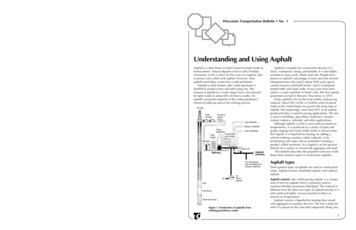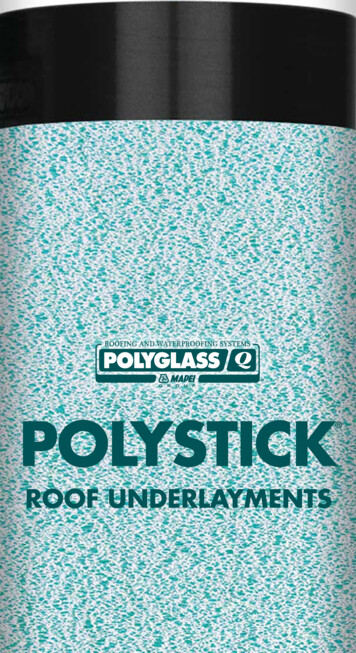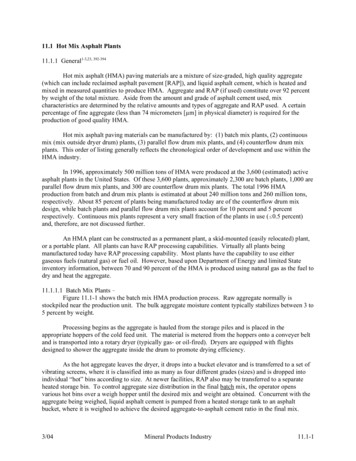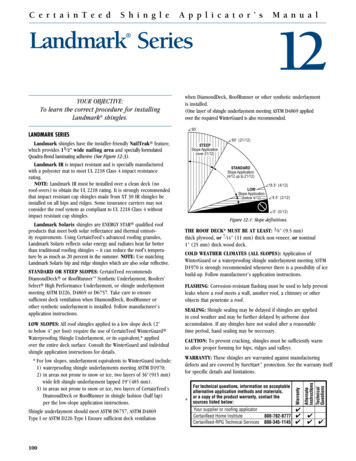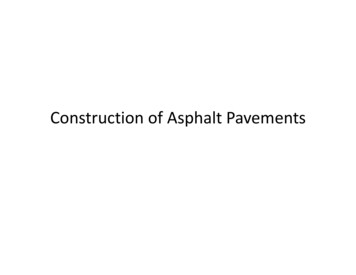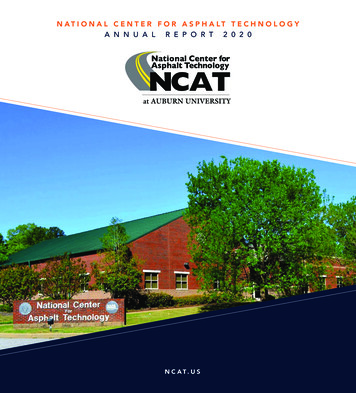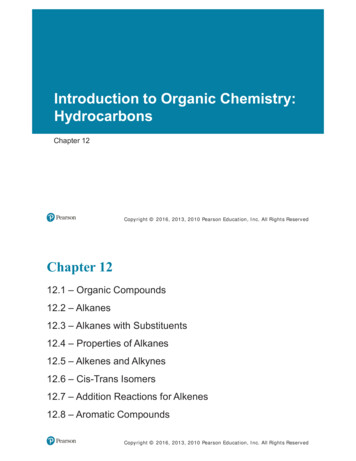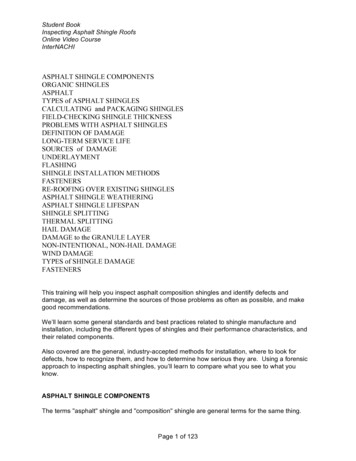
Transcription
Student BookInspecting Asphalt Shingle RoofsOnline Video CourseInterNACHIASPHALT SHINGLE COMPONENTSORGANIC SHINGLESASPHALTTYPES of ASPHALT SHINGLESCALCULATING and PACKAGING SHINGLESFIELD-CHECKING SHINGLE THICKNESSPROBLEMS WITH ASPHALT SHINGLESDEFINITION OF DAMAGELONG-TERM SERVICE LIFESOURCES of DAMAGEUNDERLAYMENTFLASHINGSHINGLE INSTALLATION METHODSFASTENERSRE-ROOFING OVER EXISTING SHINGLESASPHALT SHINGLE WEATHERINGASPHALT SHINGLE LIFESPANSHINGLE SPLITTINGTHERMAL SPLITTINGHAIL DAMAGEDAMAGE to the GRANULE LAYERNON-INTENTIONAL, NON-HAIL DAMAGEWIND DAMAGETYPES of SHINGLE DAMAGEFASTENERSThis training will help you inspect asphalt composition shingles and identify defects anddamage, as well as determine the sources of those problems as often as possible, and makegood recommendations.We’ll learn some general standards and best practices related to shingle manufacture andinstallation, including the different types of shingles and their performance characteristics, andtheir related components.Also covered are the general, industry-accepted methods for installation, where to look fordefects, how to recognize them, and how to determine how serious they are. Using a forensicapproach to inspecting asphalt shingles, you’ll learn to compare what you see to what youknow.ASPHALT SHINGLE COMPONENTSThe terms "asphalt" shingle and "composition" shingle are general terms for the same thing.Page 1 of 123
Student BookInspecting Asphalt Shingle RoofsOnline Video CourseInterNACHIThe term “composition” is used because the shingles are a composite product made from eithera fiberglass or a cellulose mat, and asphalt and minerals, as opposed to a single material, suchas wood shingles or clay tiles.All modern shingles manufactured in North America have mats made of interwoven fiberglassstrands, so you may also hear them called "fiberglass" shingles. A modern shingle consists of afiberglass mat embedded in asphalt, and covered with granules on the surface that faces theweather. The mat, asphalt and granules act together to form a durable, flexible and waterproofassembly.In the past, shingles were also manufactured using mats made of cellulose-based materials,and these are called "organic" shingles.MatThe mat provides the reinforcement that gives shingles the strength to help resist splitting,tearing and pulling over the heads of fasteners.Resistance to Heat and HumidityFiberglass shingles are designed to be resistant to heat and humidity. Warm air can hold moremoisture than cold air. Because they absorb less moisture, fiberglass shingles deform less asthey age, making them more stable in warm or damp climates.Also, because the fiberglass mat does not absorb moisture, as fiberglass shingles age and losevolatiles, they deform less than cellulose shingles. “Volatiles” are compounds in asphalt thathelp keep shingles waterproof, flexible and durable, but which dissipate over time. Most volatiledissipation is due to evaporation from overheating.Page 2 of 123
Student BookInspecting Asphalt Shingle RoofsOnline Video CourseInterNACHITim PrincePage 3 of 123
Student BookInspecting Asphalt Shingle RoofsOnline Video CourseInterNACHIORGANIC SHINGLESOrganic shingles have not been manufactured since about 2006.Cellulose used for shingle mat comes from wood chips, and recycled cardboard, rags andpaper.Cellulose mat -- also called felt -- is typically thicker than fiberglass mat.Because of their thicker, flexible, double-asphalt layer, organic shingles can be more durable incold climates than fiberglass shingles.DistortionAs organic shingles age, they slowly lose volatiles. Volatiles are compounds that boil at a lowtemperature. They dissipate over time, mostly from evaporation.Volatiles are added into the asphalt mix to help make shingles flexible, durable and waterproof.Since their loss is mainly through evaporation, loss will happen more quickly in warm climates orin homes with poor roof ventilation.As volatiles dissipate, the cellulose mat becomes dryer and more absorbent.Absorbing moisture causes shingles to expand and distort.Since organic shingles near the end of their life can hold considerably more moisture thanfiberglass, they can exhibit extreme distortion.ASPHALTAsphalt CompositionAsphalt which is used to manufacture shingles may be blended by the shingle manufacturer, orit may be bought from an asphalt supplier already blended. The methods for mixing andapplying asphalt are proprietary and manufacturers do not provide information about eitherprocess.The performance characteristics of asphalt vary according to the type and proportion ofingredients added when the asphalt is mixed.Page 4 of 123
Student BookInspecting Asphalt Shingle RoofsOnline Video CourseInterNACHIThicknessThe thickness of the asphalt layer affects shingle performance. Shingles with a thicker asphaltlayer resist fracture better than similar shingles with a thinner layer.Thickness varies among manufacturers, and even among different products by the samemanufacturer.Standards require a minimum of 15 pounds of asphalt for every 100 square feet of shingles.This is not per square of installed shingle, but of actual shingle material.Page 5 of 123
Student BookInspecting Asphalt Shingle RoofsOnline Video CourseInterNACHIBack-Surfacing“Back-surfacing” is a coat of finely pulverized mineral, such as talc, sand or limestone.Back-surfacing is applied to the backs of shingles to help keep them from sticking tomanufacturing equipment during production and from sticking to each other, once they’restacked. If you rub your finger on the back of the mat, you can feel the gritty back-surfacing.GranulesGranules embedded into the weather surfaces of shingles are made from fine-grain, opaque,crushed rock particles. Opaque granules don’t allow light to pass through.After being run through a screen to help ensure uniformity of size, they’re covered with acolored ceramic coating.Page 6 of 123
Student BookInspecting Asphalt Shingle RoofsOnline Video CourseInterNACHIThe uniformity with which granules are applied can affect the way they look on the roof.Granules have four main purposes: They reflect sunlight, which helps keep the roof cool. Keeping the roof cool will help slowthe loss of volatiles which keep shingles flexible, durable and waterproof. Reflectingsunlight also helps protect the asphalt from the damaging ultraviolet or UV radiation insunlight. Granules add weight, which helps the adhesive strip to bond well and improves windresistance. They also make shingles more durable by protecting them from weathering andabrasion. Lastly, granules improve shingle fire-resistance.Page 7 of 123
Student BookInspecting Asphalt Shingle RoofsOnline Video CourseInterNACHIAdhesive StripsDuring manufacturing, an adhesive strip of asphalt-like material is applied to the upper surfacesof the shingles. Once shingles are installed, these strips are designed to soften from the heat ofthe sun and bond to the shingles in the course placed above them.The adhesive strip is the most important component in providing wind resistance for a shingleroof. Bonding shingles to each other helps them resist uplift and keeps them lying flat so thatthey expose the minimum amount of surface for the wind to push against.This bond also helps seal the roof against moisture intrusion and allows the shingles to act, tosome degree, as a single, water-resistant membrane.Cellophane StripsIn order to keep the adhesive strips from sticking to other shingles during storage, a strip ofcellophane is installed on the underside of the shingles. These cellophane strips align with theadhesive strips while the shingles are in the package. Once shingles are installed, thecellophane strips no longer align with the adhesive, and the cellophane does not have to beremoved. In fact, it should not be removed because it often carries printed information about theshingles.Based on the information printed on this cellophane strip, you can see that this shinglemanufactured by CertainTeed complies with an ASTM Standard, and that it’s approved forinstallation in Dade County, Florida, which is a High Velocity Hurricane Zone.Page 8 of 123
Student BookInspecting Asphalt Shingle RoofsOnline Video CourseInterNACHITYPES of ASPHALT SHINGLESDuring inspections of roofs with asphalt shingles, you may see one of four basic types: threetab, laminated, interlocking, or single-piece shingles.Three-Tab ShinglesThis is a three-tab (or 3-tab) shingle. It’s a type of strip shingle.Its main identifying feature is two notches, called cutouts, which separate the lower part of theshingle into three tabs, as you can see here. A three-tab shingle is a single layer thick, usually12 inches wide and 36 inches long. Metric shingles are a little larger but are less common in theU.S.Three-tab shingles typically have warranties in the 20- to 30-year range, weigh 200 to250 pounds per square, and are designed to survive winds of up to 60 miles per hour.Laminated or Architectural/Dimensional ShinglesThis is an example of a laminated shingle, also called an “architectural” or “dimensional”shingle. Both laminated and 3-tab shingles are considered to be strip shingles.Page 9 of 123
Student BookInspecting Asphalt Shingle RoofsOnline Video CourseInterNACHILaminated shingles consist of two or more shingle layers bonded together. The uppermostlayers are smaller and cut into shapes.This gives shingles a more three-dimensional appearance and makes them more interesting tolook at. They’re sometimes designed to mimic wood shakes.Laminated shingles typically come in metric sizes, measuring about 39 x 13 inches.Laminated shingles with 30- to 50-year warranties typically weigh 250 to 300 pounds persquare, and are designed with a maximum wind resistance of 70 to 110 miles per hour.High-Quality Laminated ShinglesPage 10 of 123
Student BookInspecting Asphalt Shingle RoofsOnline Video CourseInterNACHIHere’s an example of a high-quality laminated shingle. Some of the more expensive laminatedshingles may have up to five layers and weigh close to 500 pounds per square. These shinglesmay be designed to withstand winds of up to 130 miles per hour.Interlocking ShinglesThese are examples of the most common type of interlocking shingle. They’re called T-locks.Although they’re not installed anymore, many homes were roofed with T-locks.T-lock shingles have no adhesive strip, so they rely on the interlocking profile and fasteners tohold them in place.The manufacture of T-locks ended about 2006.CALCULATING and PACKAGING SHINGLESThe amount of asphalt shingles required to cover a roof is calculated by the square. A square isan area 10x10 feet. Shingles are sold by the bundle, and a square may contain from threeto six bundles, depending on the shingle design and exposure.Page 11 of 123
Student BookInspecting Asphalt Shingle RoofsOnline Video CourseInterNACHIFIELD-CHECKING SHINGLE THICKNESSThe quality of asphalt shingles is generally reflected in the length of the warranty. You can get agood idea of the length of the warranty of strip shingles by checking the shingle thickness usinga shingle gauge.This device has a tapered slot lined with calibration marks that show the warranty connectedwith the shingle thickness. You won’t be able to positively identify the warranty of the roof, butusing the gauge allows you to get a good estimate.Here’s how you use it on a three-tab shingle.When you use the gauge on a laminated shingle, you need to use it on a portion that’s only onelayer thick. Shingle gauges are less accurate on laminated shingles.Make it clear that measuring the thickness of the shingle will identify the approximate length ofthe warranty, but does not accurately reflect the length of its expected service life.Page 12 of 123
Student BookInspecting Asphalt Shingle RoofsOnline Video CourseInterNACHIPage 13 of 123
Student BookInspecting Asphalt Shingle RoofsOnline Video CourseInterNACHIPROBLEMS WITH ASPHALT SHINGLESLet’s move on to diagnosing problems with asphalt shingles.Generally speaking, people from three different industries are likely to be inspecting asphaltshingles: insurance claims adjusters; roofing contractors; and home inspectors.Because of the many factors that can affect the condition of asphalt shingles, it’s not alwaysclear whether a defective condition or functional damage exists. Conditions are not alwaysobvious or either right or wrong.Let's define the conditions that indicate functional damage or defective installation in asphaltshingles, as well as the criteria used during an inspection to determine whether functionaldamage exists.Learning to diagnose roof conditions correctly will help those inspecting shingles to identify thesource of the damage.DEFINITION OF DAMAGEBecause inspections are so often connected with insurance claims, much of the criteria definedhere is based on the standards of the insurance industry.In this training course, “damage” is divided into two categories: functional damage andcosmetic damage.Functional DamageFunctional damage is damage that insurance companies will pay for. It’s also called covereddamage or payable damage.Functional damage is that which either diminishes the ability of the roof to shed water, orshortens its long-term service life. This is called “premature failure.”Cosmetic DamageCosmetic issues are visual issues, such as discoloration, problems with color blending, ordamage that doesn’t meet the definition of functional damage. Some examples of cosmeticdamage are general, uniform granule loss, or marring of the shingle surface.With asphalt shingle roofs, insurance companies typically don’t pay for cosmetic damage.Page 14 of 123
Student BookInspecting Asphalt Shingle RoofsOnline Video CourseInterNACHILONG-TERM SERVICE LIFEMany different forces and conditions affect the long-term service life of an asphalt shingle roof.Shingle QualityShingle quality is one condition. High-quality shingles resist weathering and damage better thanlow-quality shingles. The quality and proportions of mat, asphalt and granules are all importantvariables. Thicker shingles and shingles with multiple layers last longer.Proper InstallationThe quality of the installation is important, too.Following the manufacturer’s recommendations helps maximize the long-term service life.Manufacturers of a particular type of shingle know best how it will react to damaging anddeteriorating forces. They’re better equipped than an outside agency at choosing the installationmethod which will best maximize the shingles' long-term service life. This makes sense in lightof the fact that manufacturers issue warranties and have to stand behind their products.Contractors and installers who do not follow manufacturers' recommendations, but, instead, relyon their own past experience, may diminish the quality and workmanship of roofs so that thestructures may not perform as well or last as long, had they followed the manufacturers'recommendations during installation.Installation methods may not be limited to installation of the shingles themselves. Installation ofthe substrate, underlayment and/or flashing can also affect the long-term service life of a shingleroof.Multiple LayersPage 15 of 123
Student BookInspecting Asphalt Shingle RoofsOnline Video CourseInterNACHIDuring some roof inspections, you’ll often find newer shingles installed right over old roofcovering materials. Multiple layers get hotter and hold heat longer, so shingles won’t last aslong, although the roof is less likely to leak. Shingles installed over other shingles will also nothave a valid manufacturer’s warranty.Asphalt shingles may have been installed directly over wood shingles. This lowers their impactresistance, since there are likely more voids due to the uneven wood shingle surface.Directional OrientationSunlight deteriorates shingles. Expanses of roof that face south and southwest will get hotter,lose volatiles more quickly, and experience more extreme thermal cycling than slopes facingother directions.Roof slopes that face the prevailing winds and storm approaches may also deteriorate morequickly than protected slopes.Roof DesignRoof design features can affect the long-term service life of an asphalt shingle roof.Page 16 of 123
Student BookInspecting Asphalt Shingle RoofsOnline Video CourseInterNACHISteeper pitches shed water faster, reducing the chances of leaks and ice-dam formation.Design features that block roof drainage or cause runoff to slow or pool increase the chance ofa roof leak.Shingles on large, unbroken expanses of roof expand and contract more overall than those onsmaller roof areas. Structural features that interrupt the sheathing, such as valleys, hips andPage 17 of 123
Student BookInspecting Asphalt Shingle RoofsOnline Video CourseInterNACHIdormers, help limit expansion and contraction. Large amounts of expansion and contraction cancause problems, especially when the materials that are fastened to each other, such as roofsheathing and asphalt shingles, expand and contract at different rates.Page 18 of 123
Student BookInspecting Asphalt Shingle RoofsOnline Video CourseInterNACHIThermal Cycling“Thermal cycling” is the term used to describe the process whereby roofs get hot during day andcold during the night. When they get hot, all the roof components expand, including theshingles. When they get cold, they all contract.As shingles age, they shrink. This is especially true of organic shingles. As they shrink over thewarm part of the year and contract with the cold, shingles that bridge a joint between underlyingshingles may split.The greater the daily differences between high and low temperatures, the more all the roofingcomponents will expand and contract. Roofs exposed to extreme thermal cycling will be lessstable and will deteriorate more quickly than those exposed to less cycling.Page 19 of 123
Student BookInspecting Asphalt Shingle RoofsOnline Video CourseInterNACHIThe amount of thermal cycling experienced by shingles may be affected by: the climate zone; the number of shingle layers; the adequacy of attic ventilation; shingle color; and the properties of the granule coating.Shingle ColorShingle color can influence roof temperatures. The temperature difference between light-coloredshingles and dark-colored shingles can be up to 40 .Reducing the high temperatures that asphalt shingles reach each day can decrease thermalcycling and increase their long-term service life. Light-colored shingles installed on homes in hotclimates will probably help extend the long-term service life of asphalt shingles.Home Site ConditionsDifferent home site conditions can create different types of problems.Overhanging tree branches rubbing on the shingles can cause abrasion or tear damage.Page 20 of 123
Student BookInspecting Asphalt Shingle RoofsOnline Video CourseInterNACHIRoofs shaded by trees or mountains may stay cooler or may stay excessively moist, which canlead to microbial growth.Local wildlife, such as squirrels and raccoons, can damage shingle roofs.Leaves accumulated on the roof and in the gutters can hold moisture against the shingles, andprevent the roof from draining properly.ElevationShingles on homes at higher elevations are exposed to more ultraviolet radiation than homes atlower elevations. Since UV radiation damages the asphalt layers of shingles, shingles installedat higher elevations may have a shorter long-term service life.Quality of MaintenanceA roof may be poorly maintained for a number of reasons.Page 21 of 123
Student BookInspecting Asphalt Shingle RoofsOnline Video CourseInterNACHIPeople may not understand the importance of maintenance, or they may not know what type ofmaintenance is required. They may not be able to perform the maintenance themselves, orthey may not be able to afford to pay somebody else to do it. They may procrastinate;maintenance may just be low on their list of household priorities.Failing to perform maintenance, such as cleaning the roof and gutters and repairing roofdamage, can shorten the service life of the roof and damage home materials. You’ll see plentyof deferred maintenance as you inspect roofs.Page 22 of 123
Student BookInspecting Asphalt Shingle RoofsOnline Video CourseInterNACHISOURCES of DAMAGEYou should have knowledge regarding the common causes of problems with asphalt shingles.These problems can have many different sources. There may be no single cause; the problemmay be the result of a combination of factors.There are six common, general sources of problems. The first is installation.InstallationTo recognize installation problems, you need to understand the fundamentals of installation,along with the properties and limitations of typical roofing materials. So many products andconditions exist that discussing them all lies beyond the scope of this training course.Most shingles have to be installed according to the manufacturer’s recommendations in order toperform as they were designed and for the manufacturer’s warranty to remain in effect.Installers sometimes assume that installation methods are the same for similar shingles madeby different manufacturers. This is not always true, and this is a very important point: Similarshingles made by different manufacturers can have very different installation requirements.Proper installation of asphalt shingles isn’t limited only to the manufacturer’s recommendationsor even to the shingles. Shingles also depend on the proper installation of roof sheathing,underlayment and flashing. They all work together as a system.What constitutes proper installation of these three components varies according to whomanufactured them and what part of North America the home is located in. Installation may beaffected by building codes, too.Building CodesThe organization or entity with the legal authority to regulate roofing installation is the authorityhaving jurisdiction (AHJ). Typically, the AHJ is the local building department.Jurisdictions -- whether they're states, provinces, counties or cities -- are free to adopt whateverbuilding codes they choose, or adopt only part of a building code, or adopt no building code atall. AHJs typically defer to the manufacturers' recommendations concerning the installation ofasphalt shingles.A number of building codes exist.Page 23 of 123
Student BookInspecting Asphalt Shingle RoofsOnline Video CourseInterNACHIThe International Residential Code (IRC) is the building code most widely adopted in the U.S.It is updated every three years, so there are different versions. Before the IRC came intocommon use, the Uniform Building Code was widely used.Homes are only required to comply with building codes which were in effect at the time of thehome’s original construction, or when major work was performed. Homes are not required to beconstantly upgraded to comply with newly enacted codes. Remodel work that requires buildingpermits should comply with the building codes in effect at the time the remodel work is done.You should take the time to become familiar with the building codes that apply in your localservice area. Regulations often vary from one jurisdiction to another.Page 24 of 123
Student BookInspecting Asphalt Shingle RoofsOnline Video CourseInterNACHIUNDERLAYMENTLet’s discuss underlayment.The IRC and Manufacturers' RecommendationsThe IRC gives requirements that vary according to roof pitch and, very generally, with climate.Most major shingle manufacturers also have underlayment recommendations that are inagreement with IRC requirements.Pitch RequirementsIf you find underlayment missing on a roof with a pitch of less than 4:12, you’re fairly safe incalling it a defect. Not all shingle manufacturers require underlayment on roofs with steeppitches, when "steep” is defined as 4:12 or more, so be careful about calling missingunderlayment a defect. Installing underlayment is always a good idea, but missingunderlayment may not be a defect.Missing or improperly installed underlayment can void any warranty that might be in effect.Underlayment Installation RequirementsThe IRC and shingle manufacturers generally agree on underlayment requirements, which arethe same for felt and synthetic types.The limitations on underlayment installation vary with the pitch of the roof. The pitch of the roofis its angle of slope.Page 25 of 123
Student BookInspecting Asphalt Shingle RoofsOnline Video CourseInterNACHIThe angle of slope is described by the number of inches the roof rises in each horizontal foot.So, a roof that rises 4 inches vertically for every 12 inches of horizontal is said to have a 4:12pitch.Steep-Slope RoofsTypically, roofs with pitches of 4:12 and greater require only a single layer of underlayment, withupper courses overlapping lower courses a minimum of 2 inches. Underlayment is alwaysinstalled starting at the lower roof edge, with upper courses overlapping the lower courses.So, underlayment on steep-slope roofs should overlap 2 inches.Low-Slope RoofsRoof slopes of less than 4:12 down to 2:12 are called low-slope roofs. Two layers ofunderlayment are required for low-slope roofs. The first course is doubled. Above that, 36-inchwide strips are then applied to the roof in a shingle fashion, starting at the lower roof edge, andoverlapping subsequent courses a minimum of 19 inches.Page 26 of 123
Student BookInspecting Asphalt Shingle RoofsOnline Video CourseInterNACHIOverlapping 19 inches will ensure that the underlayment is at least two layers thick all overthe roof.So, underlayment on low-slope roofs should overlap 19 inches.Remember that underlayment on steep-slope roofs should overlap 2 inches. Also, rememberthat asphalt shingles should never be installed on roofs having a slope of less that 2:12.FastenersYou may also see underlayment installed with plastic-cap nails, which are nails inserted througha plastic disk to increase holding strength, reduce the chance of tearing, and helps reduceslipping while walking on the roof surface.Page 27 of 123
Student BookInspecting Asphalt Shingle RoofsOnline Video CourseInterNACHIIn areas that are subject to high winds, underlayment is sometimes fastened with windstrips,which are designed to resist tearing.Page 28 of 123
Student BookInspecting Asphalt Shingle RoofsOnline Video CourseInterNACHIUNDERLAYMENT in VALLEYSValleys are created where two roof slopes meet. Valleys are especially vulnerable to leakage forthree reasons:1. concentrated runoff: The combined runoff from both roof slopes is concentrated in thevalley, so valleys carry more runoff than other parts of the roof;2. interrupted roofing: The roof-covering materials are interrupted by the change in roofdirection. Any interruption in the roof-covering material increases the opportunity forleakage; and3. less slope: Although they carry more runoff, valleys slope less than the surroundingroof, so, in addition to carrying more runoff, they drain it more slowly. The chances forleakage increase as the slope of the roof decreases.Where the rest of the roof slopes at an angle, such as 4:12, where the roof rises 4 inchesvertically in every 12 inches of horizontal run a valley would rise 4 inches vertically in every 17inches of vertical run.Page 29 of 123
Student BookInspecting Asphalt Shingle RoofsOnline Video CourseInterNACHIThe reason for this is that, although valley rafters rise the same total distance as commonrafters, they do it over a longer distance because valley rafters are oriented diagonally to theridge, and common rafters are oriented perpendicular to the ridge.Valley LiningDifferent methods have been used over the years to line valleys. It can be difficult to tell exactlyhow the valley is lined on existing homes, so your best bet is to look at the lower end of thevalley at the roof edge.In newer construction or high-quality installation practices, the valley is often lined with selfadhesive underlayment, which comes with a peel-and-stick backing. Another method used is toline the valley with a layer of 90-pound underlayment, similar to roll roofing.Page 30 of 123
Student BookInspecting Asphalt Shingle RoofsOnline Video CourseInterNACHIFLASHING, Part 1IRC RequirementsThe IRC doesn’t give specific flashing details that have to be followed. It says that flashing hasto be corrosion-resistant, and installed in a manner that prevents moisture entry.Multiple methods can be used to install flashing correctly. You can check to see whetherflashing was installed in a manner that will prevent moisture entry, and you can look forcorrosion.The IRC requires roof flashing to be installed in the following locations: headwall and sidewall areas (anywhere a roof meets a wall); changes in roof slope or direction, which includes changes in pitch, and places whereroofs intersect to form hips or valleys; and around roof penetrations. "Penetrations” include anything that penetrates the roof, suchas chimneys, vents and skylights.Let's take a look at some of these areas in detail.ROOF-WALL INTERSECTIONSPlaces where roofs and walls intersect are called headwalls and sidewalls.Headwall FlashingPage 31 of 123
Student BookInspecting Asphalt Shingle RoofsOnline Video CourseInterNACHIA headwall is a junction where the top of a sloped roof meets a wall.Headwall flashing should extend up behind the exterior wall covering and down over theshingles, as you see here. This image shows counter-flashing installed behind the siding.Sometimes, the exterior wall-covering material serves as the counter-flashing, and this isacceptable.Page 32 of 123
Student BookInspecting Asphalt Shingle RoofsOnline Video CourseInterNACHIFlashing should always overlap the roof-covering material. However, for aesthetic reasons, onasphalt shingle roofs, the headwall flashing flange that extends down over the shingles is oftencovered with a course of shingle tabs.Page 33 of 123
Student BookInspecting Asphalt Shingle RoofsOnl
Tim Prince . Student Book Inspecting Asphalt Shingle Roofs Online Video Course InterNACHI Page 4 of 123 ORGANIC SHINGLES . Metric shingles are a little larger but are less common in the U.S. Three-tab shingles typically have warranties in the 20- to 30-year range, weigh 200 to .

